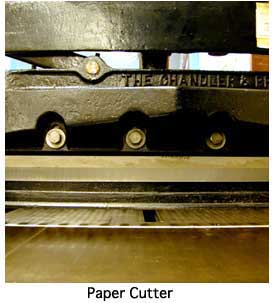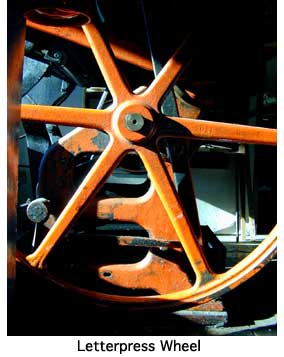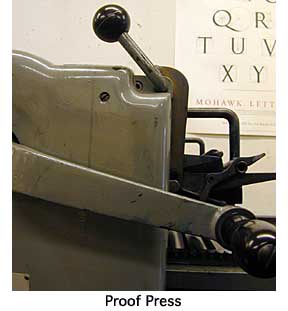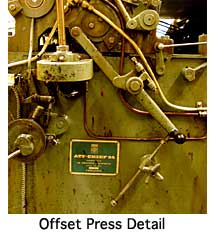 The
history of printing is also a history of people, culture and trade. Technological
changes come as they are needed and as people are ready for them. Cultures
rise to their day in the sun and fall into decline, sometimes suffering a
long darkness. Printing began as all things begin: a thousand efforts, with
no goal in sight, no big picture, combined in a thousand ways to effect a
thousand ends. The history of printing could as well be the history of civilization.
The
history of printing is also a history of people, culture and trade. Technological
changes come as they are needed and as people are ready for them. Cultures
rise to their day in the sun and fall into decline, sometimes suffering a
long darkness. Printing began as all things begin: a thousand efforts, with
no goal in sight, no big picture, combined in a thousand ways to effect a
thousand ends. The history of printing could as well be the history of civilization.
A good starting place for this brief history of the Black Art is in China, under Indian influence, where printing finds its first expression in improvements on writing.
The invention of the writing brush made from hair is attributed to General Meng Tien, in the third century BC. This allowed writing to be done on silk rather than with bamboo pens on strips of bamboo. Bamboo is heavy, bulky and awkward, but for all its virtues, silk is expensive. Paper, a cheaper writing material made from macerated mulberry bark, hemp, and old rags was invented by Ts'ai Lun, in 105 AD.
Seals originated in Babylonia, and their impressions were for millennia stamped into wax or clay as a sort of "lock and key" indication of authenticity. This in turn harks back to a simpler process of authentication: in China, a contract was written in duplicate on a piece of bamboo, which was then broken in half, and one end retained by each party. The fitting together of the broken ends provided authentication. There is some evidence that seal technology penetrated China via Alexander the Great's (356-323 BC) extensive empire, and that Hellenistic influence created an increased demand for private and imperial seals. Seal impressions stamped in ink on paper arose in China around AD 500, and provided the transition that culminates in printing from carved wooden blocks.
Seal impressions were made using vermilion, much favored by Buddhist monks. A permanent black ink suitable for brush writing was invented by Wei Tan (d. 251 AD). The ink which we now know as Chinese or India ink was made by placing a number of wicks in a vessel full of oil, while over this was placed a funnel-like cover of iron. When this was well coated with soot, the lampblack was brushed off and collected on paper. It was then mixed with a solution of gum or gluten, and, when reduced to the consistency of paste, was put into small molds. The ink was sold in sticks or elongated cubes. To prepare it for writing, it was rubbed in water on a smooth ink stone. (Carter, page 33)
Rubbings of inscriptions carved in stone also originated in China, and provided the technological and philosophical transition necessary to the invention of printing. In 175 AD, a fear that inexact copying would lead to the loss of important cultural writings led Ts'ai Yung (133-192 AD) to write the scholarly revision and corrections leading to a text of the Six Classics. This authorized version was written in his own hand on stones outside the gates of the state academy. The stone was then carved, and exact copies were made in the tens of thousands by the process of placing paper over the inscription and rubbing it with ink. The printing of books by making rubbings from incised stone carvings continued, and parallels the printing of books from wooden blocks carved in relief. (Carter 19-25)
 The
stencil and pounce, seemingly developed in or about the seventh century, were
means of reproduction of which Buddhist monks were especially fond. For the
pounce, a design was first drawn with a brush, and then outlined with needle
pricks. The pattern was then laid on a new surface, and a small bag filled
with colored chalk tapped lightly against the holes, thus transferring the
design, which could then be traced and painted accurately. Stencils were used
to color blockprinted images, and in Europe were also used to apply glue,
the tacky surface then "flocked" with colored lint.
The
stencil and pounce, seemingly developed in or about the seventh century, were
means of reproduction of which Buddhist monks were especially fond. For the
pounce, a design was first drawn with a brush, and then outlined with needle
pricks. The pattern was then laid on a new surface, and a small bag filled
with colored chalk tapped lightly against the holes, thus transferring the
design, which could then be traced and painted accurately. Stencils were used
to color blockprinted images, and in Europe were also used to apply glue,
the tacky surface then "flocked" with colored lint.
Relief printing originated during the reign of Ming Huang (712-756 AD). Small stamped figures of Buddha mark the transition from the seal impression to the woodcut. The only difference between these Buddha figures and true woodcuts, other than the primitive workmanship, is that the figures are quite small, and hence were evidently made by hand pressure like the impressions from seals. Surviving stamps have handles for this purpose. When the idea occurred to some inventive genius to turn his stamp upside down, rub it with an inked brush, lay the paper over it and rub the back, the way was open for making impressions of any size desired, and for such improvement of technique as made the new invention a force in the advancement of civilization. But first it seems to have brought about only the making of better and larger Buddha figures. (Carter, 39-40)
Although Arab culture, which so profoundly influenced a reawakened Europe, knew of Chinese printing, the refusal of its literary culture to profit from the art made Islam on the whole a barrier to the transmission of this knowledge. The logic seems to stem from ultra-conservatism: the Koran was given in handwritten form, therefore the Koran must always be written by hand. This prejudice extended toward all printing: in 1727, when permission was asked for the erection of a printing press at Constaniople, the Ulema under Sultan Ahmed III delivered a verdict that it was against the religion and honor of Islam to allow the printing of the Koran, because the Koran rested upon written tradition, and must in no other way be handed down. Permission was granted for other printing, though when in 1729 a history of Egypt appeared, such public opposition was aroused that until 1825 no further printing was attempted in the Islamic world. Islamic countries thus began a slow, inevitable slide away from their former technological and philosophical ascendance. The processes of engraving (c. 1460) and lithography (1796) were deemed acceptable for non-religious works, but the Koran itself could properly speaking only be copied by hand in single editions. Thus, though trade and commerce flourished between the Arab world and China, books in Arabic were never printed. Penetration of printing technology was left to the spread of the Mongols from the East and the Crusaders from the West. (Carter 150-153)
Found among the hidden manuscripts of the Caves of the Thousand Buddhas, near Tun-huang, was The Diamond Sutra, printed from blocks in 868 by Wang Chieh on behalf of his parents. This, the oldest extant printed book, shows an advanced technique behind which there must have been a long evolution. (Carter 56)
 The
time was right, travellers and traders in plenty went back and forth, but
there is no evidence that moveable type or type-casting technology spread
from the Orient to the Occident. Movable type did not catch on in the East
for the simple reason that as many as 30,000 Chinese ideograms are needed--some
much more than others--so that a complete font might run to the hundreds of
thousands of discrete elements. It is simpler just to cut a block with all
the characters on it for each separate page. Movable type made from clay and
later from tin was invented by Pi Sheng (1041-1048), but does not seem to
have survived his demise. Movable type made from wood appeared in China, c.
1313, but again left no lasting impression. The type mold--and with it the
use of cast metal type--was invented in Korea in 1392 and used extensively,
but there is no evidence of technological transfer.
The
time was right, travellers and traders in plenty went back and forth, but
there is no evidence that moveable type or type-casting technology spread
from the Orient to the Occident. Movable type did not catch on in the East
for the simple reason that as many as 30,000 Chinese ideograms are needed--some
much more than others--so that a complete font might run to the hundreds of
thousands of discrete elements. It is simpler just to cut a block with all
the characters on it for each separate page. Movable type made from clay and
later from tin was invented by Pi Sheng (1041-1048), but does not seem to
have survived his demise. Movable type made from wood appeared in China, c.
1313, but again left no lasting impression. The type mold--and with it the
use of cast metal type--was invented in Korea in 1392 and used extensively,
but there is no evidence of technological transfer.
The printing press, movable type, the type mold, and the invention of printing ink for use on metal are all attributed to Johannes Gutenberg (1394? 1406? -1468). The completed process appears in the form of the famous 42-line Bible of 1455 in Mainz, Germany.
Water-based Chinese ink is not suitable for taking impressions from metal. It "crawls," that is, it stands in globules on the metal surface and makes a rough impression. The first typographers of Europe, faced with this problem, solved it by using an ink whose pigment was dissolved in oil. Gutenberg took advantage of the existing technology of oil paints, which came into general use after they were perfected and popularized by the Flemish painter Jan Van Eyck (1370? - 1440?). Little modification was needed to turn oil paint into printing ink. (Bloy, 4-5)
The printing press used by Gutenberg was a clever adaptation of the screw mechanisms available in the wine press, the papermaker's press and the common linen press. One Konrad Saspach, a wood turner, was commissioned to begin building a press for Gutenberg after the death in December 1438 of Andreas Dritzehen, one of Gutenberg's early partners. The form of the first printing press, which did not change in essence for nearly four hundred years, must have resulted from a series of experiments by Gutenberg and Saspach, and by printers in the next few decades. (Moran, 21)
The goldsmiths of Florence in the middle of the 15th century were in the habit of ornamenting their works by means of engraving, after which they filled up the hollows produced by the burin with a black enamel made of silver, lead and sulphur, the result being that the design was rendered much more visible by the contrast between the metal and the enamel. An engraved design filled up in this manner was called a niello. Before this laborious and essentially irreversible process was resorted to, a "smoke-proof" was obtained by filling the lines with lampblack. At a slightly later time it was discovered that a printed proof could be taken on damped paper by filling the engraved lines with ink and wiping the excess off the surface, then pressing the paper against the engraved lines, thus transferring the design to the paper. The metal engravers, however, saw no further than this. The process of engraving as a printing method is attributed to Maso Finiguerra (1426-1464) of Florence, who developed the technique of copperplate line engraving around 1460. The few good copies obtainable before the plate became badly worn limited its utility, and it was not until the time of the German Albrecht Dürer (1471-1528), who is regarded as the inventor of etching, that engraving on metal became an established method of printing images in useful quantity. In an etching, the plate is coated with an acid-resistant ground, the ground is partially removed with etching tools, and the exposed areas are then bitten with acid. The etched lines are then printed in the same manner as an engraving.
 Learned
from the Chinese, woodblock printing flowered in Japan during the Edo period
(1635-1867). The ukio-e (transitory world) print celebrated the life of the
pleasure quarters of Edo. Hishikawa Moronobu (1618-1694) was the first artist
to design and print monochrome single-sheet woodblock prints. Kiomitsu (1735-1785)
produced polychrome prints, and the work of his pupil Torii Kiohiro (fl. 1737-1776)
continued the experimentation. In 1741, a color printing process was invented,
and in 1745 the publisher Kichiemon Kamimura introduced the kento, or registration
mark, to woodblock printing. (Yoshida, et al. 28-30)
Learned
from the Chinese, woodblock printing flowered in Japan during the Edo period
(1635-1867). The ukio-e (transitory world) print celebrated the life of the
pleasure quarters of Edo. Hishikawa Moronobu (1618-1694) was the first artist
to design and print monochrome single-sheet woodblock prints. Kiomitsu (1735-1785)
produced polychrome prints, and the work of his pupil Torii Kiohiro (fl. 1737-1776)
continued the experimentation. In 1741, a color printing process was invented,
and in 1745 the publisher Kichiemon Kamimura introduced the kento, or registration
mark, to woodblock printing. (Yoshida, et al. 28-30)
Lithography (stone writing), based on the simple principle that oil and water won't mix, was invented by the Bavarian, Aloys Senefelder, in 1796. Its first application was in the printing of music, theretofore done at great labor and expense by copperplate engraving. From the freedom of expression inherent in the medium, the new process stimulated the wildest variety of typographic fancies. Chromolithography, the printing of multiple colors in tight register, was developed and named by M. Godefroi Engelman of MŸlhausen in 1837. Jules Cheret, called the father of the poster, improved upon this process and reduced the number of colors--usually to three--by printing with spatter tints. The combination of Cheret's formal training as a lithographic printer and the influence of Japanese woodblock prints of the ukio-e combined in 1866 to revolutionize the manner in which commercial images were presented to the public.
Photography (light writing) originates with the camera obscura (dark box), the principles of which seem to have been well understood by Euclid in his Optics (300 BC) and in Aristotle's (384-322 BC) Problems. Few allusions to the phenomena described in these books occur in later classical writers, and the first scientific investigation occurs in the great optical treatise of the Arabian philosopher Alhazen (d. Cairo 1038) Various observations from 1782 through 1802 on the photoreactive properties of silver chloride, silver nitrate and ammonia led the Englishman, Thomas Wedgewood, (1771-1805) to produce an actual photograph, which, however, he could not preserve. The first to create a photograph that was subsequently unaffected by light was the Frenchman, Nicéphore de Niepce, (1765-1833) in 1827. Niepce had from 1811 devoted himself to the rising art of lithography, and in 1813 the idea of obtaining sun pictures occurred to him in this connection. In 1826 he learned that Louis Jacques Mandé Daguerre (1789-1851) was working along similar lines, and formed with him a partnership. After Niepce's death, Daguerre improved upon the process, lending his name to the Daguerrotype. The photographic print was created by William Henry Fox Talbot (1800-1877), who in January of 1839 described the first of his inventions and discoveries in a paper to the Royal Society.
Process (as half-tone process, four-color process) is a general term technically employed for the photo-mechanical process by which illustrations are reproduced in printing. The outcome of a discovery by Mungo Ponton, that a preparation of albumen or other colloidal substance and bichromate of potash could be hardened and rendered insoluble and nonabsorbent in water by exposure to light, and that as a photographic negative permitted the passage through it of light in varying degrees of intensity, so a film of the preparation placed under a negative was liable to be hardened and rendered insoluble in degrees varying with the intensity of the light affecting it. This discovery governs the production of process blocks or plates of all kinds. (Encyclopaedia Brittanica, 11th edition, article "Process")
The invention of line process stimulated the invention of the half-tone process, in which an image is broken up into myriad tiny dots by the passage of light through a half tone screen, and thence to a negative from which a letterpress cut or lithographic plate can be made, and the image then printed at the same time as the text. The techniques necessary to this matured between 1852 and 1886, mostly in the development of suitable glass screens.
In 1861, James Clerk Maxwell (Scottish, 1831-1879) suggested that objects
could be reproduced in their natural colors by superimposing the three primary
colors. Various experiments in separating images for printing by means of
colored filters resulted in the first three-color blocks for letterpress printing,
which were developed by F. E. Ives, of Philadelphia, in 1881.
 Three
major 19th century planographic (flat surfaced) printing processes, all dependent
on photography and utilizing the nature of colloids, were for a time important.
They are Woodburytype (Walter Woodbury, English, 1834 - 1885); Stenotype and
Collotype. Woodbury type and Stenotype utilized delicate photographic molds,
which were inked and impressed on paper so as to reproduce varying degrees
of light and shadow reflecting the depth of the cast.
Three
major 19th century planographic (flat surfaced) printing processes, all dependent
on photography and utilizing the nature of colloids, were for a time important.
They are Woodburytype (Walter Woodbury, English, 1834 - 1885); Stenotype and
Collotype. Woodbury type and Stenotype utilized delicate photographic molds,
which were inked and impressed on paper so as to reproduce varying degrees
of light and shadow reflecting the depth of the cast.
Collotype or photogelatin printing was invented in 1870 by Joseph Albert of Munich. Collotype produced admirable color images without the use of screens (screenless printing is called continuous tone, somewhat like a photograph), and was for a time used in the production of color postcards, point-of-purchase displays and high-quality reproductions of fine art. Collotype was a viable method of printing as late as 1990.
The heliotype (sun print) process employed film and rendered a small number of photographic-quality images before wearing out.
The monotype (single print) process, whereby an original painting on glass, plastic or metal is transferred to a piece of paper using a printing press, is still much employed as a fine art medium.
The rubber blanket, a final step in the evolution of lithography, was introduced in Chicago in 1906. This allowed a significant reduction in the pressure of printing from a zinc or aluminum lithographic plate, as the plate touched the rubber blanket with only enough pressure to transfer the image, and from thence the blanket transferred the now reversed image to the paper, again, with only a "kiss" impression. These three inventions, over the period of a century, contributed their names to photo-offset-lithography.
In 1868, an American patent was taken out by C. L. Sholes and C. Glidden for a typewriter which, after effecting various improvements, they licensed manufacture to Remington and Sons, gunmakers, of Ilion, New York in 1875. The original machine had capital letters only, but in 1878 a machine was introduced which could produce both upper and lower case. The legacy of the typewriter--and one that will be with us for the foreseeable future--is the peculiar arrangement of the keyboard, which was designed originally to prevent frequently used keys from tangling with one another. Once learned, there is no reason to unlearn, though there is no longer any mechanical obstacle to any arrangement of keys whatever. Rational or irrational, the QWERTY keyboard is here to stay.
Among James Watt's (Scottish, 1736-1819) contributions was the letter copying
press, for copying manuscript by using a glutinous ink and pressing the written
page against a moistened sheet of thin paper. Patented in 1780, this led to
the invention and development of the hectographic or gelatin duplicator.
In 1856, British chemist William Henry Perkins (1838-1907) discovered the first synthetic dye, aniline purple. This pointed the way to a wide range of new inks, including "copying ink" used in the first practical method of reproducing business documents. An original written with copying ink was placed against a moistened sheet of tissue, the two were pressed together in a massive iron press, and a copy would appear on the tissue. Since the copy was backwards, the tissue had to be held up to the light to be read. The copy press became a fixture in every Victorian office. Today, they are sold in antique shops as "book presses," their true function long forgotten. (Dead Media, 1999)
The hektograph (hundred writer) was invented in the 1870s, and used a stiff
gelatin pad coupled with special ink made with aniline dye. A document written
with the ink was pressed to the pad. The gelatin absorbed the ink after a
few minutes, and the original was removed. Blank sheets were then pressed
against the pad, and the gelatin released a little of the ink each time, producing
a positive copy. The hektograph was good for about 50 impressions. Twentieth-century
spirit duplicators (such as "Ditto") were a later outgrowth of the
hektograph and much easier to use. (Dead Media, 1999)
 The
spirit duplicator was invented in 1923 by Wilhelm Ritzerfeld, founder of the
Ormig Company in Germany. The spirit duplicator master consisted of a smooth
paper master sheet and a paper sheet, coated with a waxy compound similar
to that used in the hektograph, acting backwards so that the wax compound
was transferred to the back side of the master sheet itself. The master could
be typed or written on, and when finished the waxy paper original was discarded.
The master was wrapped around a drum in the spirit duplicator machine. As
the drum turned, the master was coated with a thin layer of highly volatile
duplicating fluid via a wick soaked in the fluid. The fluid acted to slightly
dissolve or soften the dye. As paper (preferably calendered or coated) pressed
against the drum and master copy, some of the image was transferred to make
the final copy. A spirit duplicator master was capable of making up to 500
copies before the print became too faint to recognize. (Dead Media, 1999)
The
spirit duplicator was invented in 1923 by Wilhelm Ritzerfeld, founder of the
Ormig Company in Germany. The spirit duplicator master consisted of a smooth
paper master sheet and a paper sheet, coated with a waxy compound similar
to that used in the hektograph, acting backwards so that the wax compound
was transferred to the back side of the master sheet itself. The master could
be typed or written on, and when finished the waxy paper original was discarded.
The master was wrapped around a drum in the spirit duplicator machine. As
the drum turned, the master was coated with a thin layer of highly volatile
duplicating fluid via a wick soaked in the fluid. The fluid acted to slightly
dissolve or soften the dye. As paper (preferably calendered or coated) pressed
against the drum and master copy, some of the image was transferred to make
the final copy. A spirit duplicator master was capable of making up to 500
copies before the print became too faint to recognize. (Dead Media, 1999)
The mimeograph (copy writer) was invented in 1887 by the American, Thomas Alva Edison (1847-1931). It is a duplicating process by which a waxed stencil is typed or written upon, thus opening avenues for ink to penetrate. The stencil is then fitted around an inked drum, which when rotated transfers the image to paper. Inexpensive and highly accessible, the mimeograph was a staple of propagandists through the mid-1960s. After purchasing the rights to Edison's process of making stencils, in 1887 the A. B. Dick company began selling copying equipment under the trade name "Edison's Mimeograph." The device made copies of hand-drawn stencils one at a time on a flat bed duplicator. By the time Dick began selling the device, the Gestetner company in England was already selling a similar machine called the cyclostyle, but mimeograph became the generic term.
The blueprint process, also called cyanotype, is still in use, though its
day as a commercial process is passing. The Cyanotype was developed in the
1840's, and is part of a group of processes that include the palladium print,
the platinotype and the kallitype. The common element is that these are all
iron salt processes. Iron-salt processes basically work like this: All ferric(iron)
salts, when combined with organic substances, become sensitive to light. A
commonly used mixture is ferric ammonium citrate and potassium ferricyanide.
Exposure to actinic light breaks down the iron compound by oxidation, thereby
releasing carbon in the form of carbonic acid. The exposed print is then immersed
in water, causing a reaction between the new compound (peroxide iron salt)
and the potassium ferricyanide. Thus formed is a deep-blue compound (ferroprussiate).
(Cyanotype web page)
The Diazo proscess (also called Diazotype, Ozalid or Blueline), was a photographic
process developed in the 1890's. It required a translucint original which
was contact printed onto a sheet of stock sensitized with a diazonium compound,
and developed by exposure to anhydrous ammonia vapors. One of the least expensive
means of reproduction, it was nonetheless limited in use because of its number
of fixed colors and rapid fading. The proscess was used primarily for proofs
and trial prints and was employed thrugh the 1980's.
Late 18th century Japanese stencils for fabric printing have the delicate
isolated parts tied into the general pattern with silk thread, but there was
no fabric backing to hold the whole together. The stencil image was printed
using a large soft brush, which did not damage the delicate paper pattern.
(Tuer, 6)
Stencil printing became commercially viable in the West only after considerable
improvements were made to the equipment. The rubber blade of a squeegee was
one such advancement. The idea of using silk fabric as a screen or ground
to hold a tieless stencil is generally credited to Samuel Simon of Manchester,
who was granted a silk screen process patent in England in 1907.
A multicolor method was developed by John Pilsworth of San Francisco in 1914.
Anthony Velonis, a WPA artist, coined the term serigraph (silk writing) to
distinguish the otherwise identical fine art application from the commercial.
These foundation stones of electronic printing survive in otherwise meaningless terminology (leading, upper and lower case, font, &c.) and in the legacy conferred by those who were trained in the older methods. But, just as the child is the father of the man, so is the antique technological process the father of the new.
Bibliography
Ancient Writing and its Influence, B. L. Ullman, Longmans, Green & Company,
New York, 1932
The Art of Written Forms: The Theory and Practice of Calligraphy, Donald
M. Anderson, Holt Rinehart and Winston, 1969
Before Photocopying: The Art and History of Mechanical Copying, 1780 to 1938:
Barbara J. Rhodes & William W. Streeter, Oak Knoll Press, 1999
Before Writing, Volume I: From Counting to Cuneiform, Denise Schmandt-Besserat,
University of Texas Press, 1992
A Complete Course of Lithography, Aloys Senefelder, London, 1819
Dead Media Website, 1999
Encyclopaedia Brittanica, 11th edition, 1911
A History of Printing Ink, Balls and Rollers, 1440-1850, C. H. Bloy, The
Wynken de Worde Society, 1967
The Invention of Printing in China and Its Spread Westward, Thomas Francis
Carter, The Ronald Press Company, 1925
Japanese Stencil Designs, Andrew W. Tuer, Leadenhall Press, 1892 (Dover facsimile,
1967)
Johann Gutenberg and His Bible: A Historical Study, Janet Ing, The Typophiles,
1988
Printing Presses: History and Development from the 15th Century to Modern
Times, James Moran, University of California Press, 1973
A Short History of the Printed Word, Warren Chappell, Nonpareil Books, Boston,
1980
Silk Screen Techniques, J. I. Biegeleisen and Max Arthur Cohn, Dover, 1942
& 1958
Ukio-e: 250 Years of Japanese Art, Roni Neuer, Herbert Libertson, Susugu Yoshida, Mayflower Books, 1978
All images by David Lance Goines ©2002